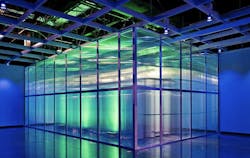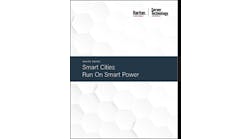We’re in the midst of a digital transformation of the global economy. Technologies like artificial intelligence, the Internet of Things, augmented reality and blockchain are gaining traction. Autonomous vehicles loom on the horizon. No one’s entirely sure what this future will look like.
But your data center will need to be ready for it.
This is the principle guiding Aligned Energy and its approach to intelligent infrastructure. The flexibility to support future requirements – especially higher higher power densities – has been a focal point in the data center design for Aligned, which seeks to “future proof” customers from evolving trends in rack density and applications.
“We are focused not only on solving the challenges of today, but also the technical challenges throughout the life of that customer’s relationship with us,” said Andrew Schaap, the CEO of Aligned Energy. “I see this becoming a more central concern for big buyers. Some of them are refreshing their hardware every two to three years.”
Future Proofing Space for Growing Clients
Aligned’s focus on future-proofing is winning business. The company has landed several large wholesale deals in Phoenix, helping fill much of the 150,000 square foot first phase of its huge facility Phoenix. Less than a year after opening the facility, Aligned announced this week that it has begun work on Phase II of the Phoenix site, and will develop an additional 200,000 square feet of data center space. The new phase will bring 60 megawatts of capacity to the 51-acre property, which can support up to 120 megawatts of commissioned power.
Studies of the wholesale market from North American Data Centers report that Aligned signed at least 7 megawatts in leases with marquee customers in 2017. Aligned doesn’t publicly report the specifics of its leasing, but said the expansion is based on demand, including the need to create capacity for existing users who pursue a “land and expand” strategy of expansion within an existing campus.
The lobby of the Aligned Energy data center in Phoenix, which is being expanded by 200,000 square feet. (Photo: Aligned Energy)
“We are thrilled to increase our floorplate to welcome new clients and continue to grow with existing ones as they look for a partner that is responsive, experienced and always at the forefront of engineering transformative solutions,” said Schaap.
“I’ve always been a big believer in the Phoenix market,” he added. “This expansion is in large part due to the success in the adoption of the Aligned platform, both here in Phoenix and across the US.”
Adaptive Approach Leads With Cooling
Aligned was founded in 2015 with a focus on solving capacity management challenges, pursuing innovation in cooling and the supply chain. The company launched its first data center in Plano, Texas in 2016 and its second site in Phoenix in May 2017. Aligned describes its design as an “adaptive data center” and says it can support a PUE (Power Usage Efficiency) of 1.15 in any climate. Building its first two data centers in warm climates showcases the adaptability of Aligned’s technology.
Its design enables tenants to put low-density and high-density racks next to one another in a data hall, a configuration which is often problematic. Aligned says its technology can cool cabinets housing up to 50kW per rack in IT equipment.
The company’s refrigerant-based cooling system has multiple components, which include:
- A rack enclosure using hot aisle containment.
- A cooling unit known as an eSync that sits atop the enclosure.
- A cooling distribution unit (CDU).
- A pump house that provides low-energy pumps.
- A “cactus cooler” unit that rejects the heat outside the building.
The eSync cooling unit sits on top of the enclosure, and uses a refrigerant system and heat sink to cool exhaust heat from the hot aisle and return it to the front of the enclosure and the server inlets. The refrigerant is pumped by a cooling distribution unit (CDU) with a heat exchanger that allows the system to use free cooling – tapping cool outside air to support the cooling system.
Emphasis on R&D
Aligned continues to refine its design, Schaap said, with refinements available for new phases construction. “You build incrementally,” he said. “We’re continuing to make design improvements with each new build.”
According to Schaap, Aligned’s ability to balance an engineering-driven culture with real estate expertise is more important than ever in the data center industry.
“Technology changes businesses, and innovation is really important for our clients,” said Schaap. “We’re thinking through these problems in a commercial sense and a technical sense. At this point, our R&D and the fact that we can approach things differently seems to be piquing everyone’s interest.”
And for further coverage, check out Data Center Frontier’s page dedicated to the Phoenix Data Center Market, that will provide the latest stats and info on this quickly growing area that is becoming a leading market in the colocation industry.






